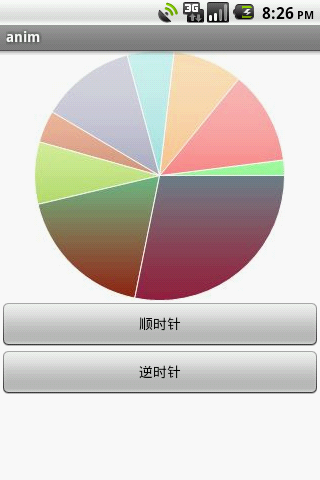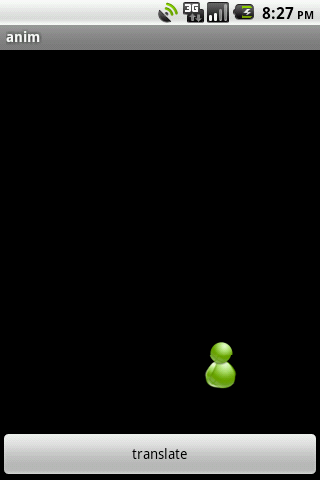详解Android动画之Tween Animation
来源:互联网 发布:unity3d美工 编辑:程序博客网 时间:2024/06/05 14:24
前面讲了动画中的Frame动画,今天就来详细讲解一下Tween动画的使用。
同样,在开始实例演示之前,先引用官方文档中的一段话:
Tween动画是操作某个控件让其展现出旋转、渐变、移动、缩放的这么一种转换过程,我们成为补间动画。我们可以以XML形式定义动画,也可以编码实现。
如果以XML形式定义一个动画,我们按照动画的定义语法完成XML,并放置于/res/anim目录下,文件名可以作为资源ID被引用;如果由编码实现,我们需要使用到Animation对象。
如果用定义XML方式实现动画,我们需要熟悉一下动画XML语法:
<?xml version="1.0" encoding="utf-8"?><set xmlns:android="http://schemas.android.com/apk/res/android" android:interpolator="@[package:]anim/interpolator_resource" android:shareInterpolator=["true" | "false"] > <alpha android:fromAlpha="float" android:toAlpha="float" /> <scale android:fromXScale="float" android:toXScale="float" android:fromYScale="float" android:toYScale="float" android:pivotX="float" android:pivotY="float" /> <translate android:fromX="float" android:toX="float" android:fromY="float" android:toY="float" /> <rotate android:fromDegrees="float" android:toDegrees="float" android:pivotX="float" android:pivotY="float" /> <set> ... </set></set>
XML文件中必须有一个根元素,可以是<alpha>、<scale>、<translate>、<rotate>中的任意一个,也可以是<set>来管理一个由前面几个元素组成的动画集合。
<set>是一个动画容器,管理多个动画的群组,与之相对应的Java对象是AnimationSet。它有两个属性,android:interpolator代表一个插值器资源,可以引用系统自带插值器资源,也可以用自定义插值器资源,默认值是匀速插值器;稍后我会对插值器做出详细讲解。android:shareInterpolator代表<set>里面的多个动画是否要共享插值器,默认值为true,即共享插值器,如果设置为false,那么<set>的插值器就不再起作用,我们要在每个动画中加入插值器。
<alpha>是渐变动画,可以实现fadeIn和fadeOut的效果,与之对应的Java对象是AlphaAnimation。android:fromAlpha属性代表起始alpha值,浮点值,范围在0.0和1.0之间,分别代表透明和完全不透明,android:toAlpha属性代表结尾alpha值,浮点值,范围也在0.0和1.0之间。
<scale>是缩放动画,可以实现动态调控件尺寸的效果,与之对应的Java对象是ScaleAnimation。android:fromXScale属性代表起始的X方向上相对自身的缩放比例,浮点值,比如1.0代表自身无变化,0.5代表起始时缩小一倍,2.0代表放大一倍;android:toXScale属性代表结尾的X方向上相对自身的缩放比例,浮点值;android:fromYScale属性代表起始的Y方向上相对自身的缩放比例,浮点值;android:toYScale属性代表结尾的Y方向上相对自身的缩放比例,浮点值;android:pivotX属性代表缩放的中轴点X坐标,浮点值,android:pivotY属性代表缩放的中轴点Y坐标,浮点值,对于这两个属性,如果我们想表示中轴点为图像的中心,我们可以把两个属性值定义成0.5或者50%。
<translate>是位移动画,代表一个水平、垂直的位移。与之对应的Java对象是TranslateAnimation。android:fromXDelta属性代表起始X方向的位置,android:toXDelta代表结尾X方向上的位置,android:fromYScale属性代表起始Y方向上的位置,android:toYDelta属性代表结尾Y方向上的位置,以上四个属性都支持三种表示方式:浮点数、num%、num%p;如果以浮点数字表示,代表相对自身原始位置的像素值;如果以num%表示,代表相对于自己的百分比,比如toXDelta定义为100%就表示在X方向上移动自己的1倍距离;如果以num%p表示,代表相对于父类组件的百分比。
<rotate>是旋转动画,与之对应的Java对象是RotateAnimation。android:fromDegrees属性代表起始角度,浮点值,单位:度;android:toDegrees属性代表结尾角度,浮点值,单位:度;android:pivotX属性代表旋转中心的X坐标值,android:pivotY属性代表旋转中心的Y坐标值,这两个属性也有三种表示方式,数字方式代表相对于自身左边缘的像素值,num%方式代表相对于自身左边缘或顶边缘的百分比,num%p方式代表相对于父容器的左边缘或顶边缘的百分比。
另外,在动画中,如果我们添加了android:fillAfter="true"后,这个动画执行完之后保持最后的状态;android:duration="integer"代表动画持续的时间,单位为毫秒。
如果要把定义在XML中的动画应用在一个ImageView上,代码是这样的:
ImageView image = (ImageView) findViewById(R.id.image);Animation testAnim = AnimationUtils.loadAnimation(this, R.anim.test);image.startAnimation(testAnim);
下面重点介绍一下插值器的概念:
首先要了解为什么需要插值器,因为在补间动画中,我们一般只定义关键帧(首帧或尾帧),然后由系统自动生成中间帧,生成中间帧的这个过程可以成为“插值”。插值器定义了动画变化的速率,提供不同的函数定义变化值相对于时间的变化规则,可以定义各种各样的非线性变化函数,比如加速、减速等。下面是几种常见的插值器:
然后我们可以这样使用一个插值器:
<set android:interpolator="@android:anim/accelerate_interpolator">...</set>
<alpha android:interpolator="@android:anim/accelerate_interpolator".../>
如果只简单地引用这些插值器还不能满足需要的话,我们要考虑一下个性化插值器。我们可以创建一个插值器资源修改插值器的属性,比如修改AnticipateInterpolator的加速速率,调整CycleInterpolator的循环次数等。为了完成这种需求,我们需要创建XML资源文件,然后将其放于/res/anim下,然后再动画元素中引用即可。我们先来看一下几种常见的插值器可调整的属性:
<accelerateDecelerateInterpolator> 无
<accelerateInterpolator> android:factor 浮点值,加速速率,默认为1
<anticipateInterploator> android:tension 浮点值,起始点后退的张力、拉力数,默认为2
<anticipateOvershootInterpolator> android:tension 同上 android:extraTension 浮点值,拉力的倍数,默认为1.5(2 * 1.5)
<bounceInterpolator> 无
<cycleInterplolator> android:cycles 整数值,循环的个数,默认为1
<decelerateInterpolator> android:factor 浮点值,减速的速率,默认为1
<linearInterpolator> 无
<overshootInterpolator> 浮点值,超出终点后的张力、拉力,默认为2
下面我们就拿最后一个插值器来举例:
<?xml version="1.0" encoding="utf-8"?><overshootInterpolator xmlns:android="http://schemas.android.com/apk/res/android" android:tension="7.0"/>上面的代码中,我们把张力改为7.0,然后将此文件命名为my_overshoot_interpolator.xml,放置于/res/anim下,我们就可以引用到自定义的插值器了:
<scale xmlns:android="http://schemas.android.com/apk/res/android" android:interpolator="@anim/my_overshoot_interpolator" .../>如果以上这些简单的定义还不能满足我们的需求,那么我们就需要考虑一下自己定义插值器类了。
我们可以实现Interpolator接口,因为上面所有的Interpolator都实现了Interpolator接口,这个接口定义了一个方法:float getInterpolation(float input);
此方法由系统调用,input代表动画的时间,在0和1之间,也就是开始和结束之间。
线性(匀速)插值器定义如下:
public float getInterpolation(float input) { return input; }加速减速插值器定义如下: public float getInterpolation(float input) { return (float)(Math.cos((input + 1) * Math.PI) / 2.0f) + 0.5f; }有兴趣的话,大家可以尝试一下自定义一个插值器。讲了这么久的概念,下面我们就结合实例来演示一下几种Tween动画的应用。
先来介绍一下旋转动画的使用,布局文件/res/layout/rotate.xml如下:
<?xml version="1.0" encoding="utf-8"?><LinearLayout xmlns:android="http://schemas.android.com/apk/res/android" android:orientation="vertical" android:layout_width="fill_parent" android:layout_height="fill_parent" android:background="#FFFFFF"> <ImageViewandroid:id="@+id/piechart"android:layout_width="wrap_content"android:layout_height="wrap_content"android:layout_gravity="center_horizontal"android:src="@drawable/piechart"/> <Buttonandroid:id="@+id/positive"android:layout_width="fill_parent"android:layout_height="wrap_content"android:text="顺时针"android:onClick="positive"/> <Buttonandroid:id="@+id/negative"android:layout_width="fill_parent"android:layout_height="wrap_content"android:text="逆时针"android:onClick="negative"/></LinearLayout>我们定义了一个ImageView,用于显示一个饼状图,演示旋转动画,然后定义了两个按钮,用以运行编码实现的动画。动画定义文件/res/anim/rotate.xml如下:
<?xml version="1.0" encoding="utf-8"?><set xmlns:android="http://schemas.android.com/apk/res/android"android:interpolator="@android:anim/accelerate_decelerate_interpolator"><rotateandroid:fromDegrees="0"android:toDegrees="+360"android:pivotX="50%"android:pivotY="50%"android:duration="5000"/></set>最后再来看一下RotateActivity.java代码:
package com.scott.anim;import android.app.Activity;import android.os.Bundle;import android.view.View;import android.view.animation.Animation;import android.view.animation.AnimationUtils;import android.view.animation.LinearInterpolator;import android.view.animation.RotateAnimation;public class RotateActivity extends Activity {private int currAngle;private View piechart;@Overridepublic void onCreate(Bundle savedInstanceState) {super.onCreate(savedInstanceState);setContentView(R.layout.rotate);piechart = findViewById(R.id.piechart);Animation animation = AnimationUtils.loadAnimation(this, R.anim.rotate);piechart.startAnimation(animation);}public void positive(View v) {Animation anim = new RotateAnimation(currAngle, currAngle + 180, Animation.RELATIVE_TO_SELF, 0.5f,Animation.RELATIVE_TO_SELF, 0.5f);/** 匀速插值器 */LinearInterpolator lir = new LinearInterpolator();anim.setInterpolator(lir);anim.setDuration(1000);/** 动画完成后不恢复原状 */anim.setFillAfter(true);currAngle += 180;if (currAngle > 360) {currAngle = currAngle - 360;}piechart.startAnimation(anim);}public void negative(View v) {Animation anim = new RotateAnimation(currAngle, currAngle - 180, Animation.RELATIVE_TO_SELF, 0.5f,Animation.RELATIVE_TO_SELF, 0.5f);/** 匀速插值器 */LinearInterpolator lir = new LinearInterpolator();anim.setInterpolator(lir);anim.setDuration(1000);/** 动画完成后不恢复原状 */anim.setFillAfter(true);currAngle -= 180;if (currAngle < -360) {currAngle = currAngle + 360;}piechart.startAnimation(anim);}}然后,看一下渐变动画,布局文件/res/layout/alpha.xml如下:<?xml version="1.0" encoding="utf-8"?><FrameLayout xmlns:android="http://schemas.android.com/apk/res/android" android:layout_width="fill_parent" android:layout_height="fill_parent" android:background="#FFFFFF"> <ImageView android:id="@+id/splash" android:layout_width="fill_parent" android:layout_height="fill_parent" android:layout_gravity="center" android:src="@drawable/splash"/> <Button android:layout_width="fill_parent" android:layout_height="wrap_content" android:layout_gravity="bottom" android:text="alpha" android:onClick="alpha"/></FrameLayout>动画定义文件/res/anim/alpha.xml如下:
<?xml version="1.0" encoding="utf-8"?><set xmlns:android="http://schemas.android.com/apk/res/android"><alphaandroid:fromAlpha="0.0"android:toAlpha="1.0"android:duration="3000"/></set>AlphaActivity.java代码如下:
package com.scott.anim;import android.app.Activity;import android.os.Bundle;import android.util.Log;import android.view.View;import android.view.animation.AlphaAnimation;import android.view.animation.Animation;import android.view.animation.Animation.AnimationListener;import android.view.animation.AnimationUtils;import android.widget.ImageView;public class AlphaActivity extends Activity implements AnimationListener {private ImageView splash;@Overrideprotected void onCreate(Bundle savedInstanceState) {super.onCreate(savedInstanceState);setContentView(R.layout.alpha);splash = (ImageView) findViewById(R.id.splash);Animation anim = AnimationUtils.loadAnimation(this, R.anim.alpha);anim.setAnimationListener(this);splash.startAnimation(anim);}public void alpha(View view) {Animation anim = new AlphaAnimation(1.0f, 0.0f);anim.setDuration(3000);anim.setFillAfter(true);splash.startAnimation(anim);}@Overridepublic void onAnimationStart(Animation animation) {Log.i("alpha", "onAnimationStart called.");}@Overridepublic void onAnimationEnd(Animation animation) {Log.i("alpha", "onAnimationEnd called");}@Overridepublic void onAnimationRepeat(Animation animation) {Log.i("alpha", "onAnimationRepeat called");}}接着看一下位移动画,布局文件/res/layout/translate.xml如下:<?xml version="1.0" encoding="utf-8"?><FrameLayout xmlns:android="http://schemas.android.com/apk/res/android" android:orientation="vertical" android:layout_width="fill_parent" android:layout_height="fill_parent"> <ImageView android:id="@+id/trans_image" android:layout_width="wrap_content" android:layout_height="wrap_content" android:layout_weight="1" android:src="@drawable/person"/> <Button android:id="@+id/trans_button" android:layout_width="fill_parent" android:layout_height="wrap_content" android:layout_gravity="bottom" android:text="translate" android:onClick="translate"/></FrameLayout>动画定义文件/res/anim/translate.xml如下:
<?xml version="1.0" encoding="utf-8"?><set xmlns:android="http://schemas.android.com/apk/res/android"android:interpolator="@android:anim/bounce_interpolator"><translateandroid:fromXDelta="0"android:fromYDelta="0"android:toXDelta="200"android:toYDelta="300"android:duration="2000"/></set>然后TranslateActivity.java代码如下:
package com.scott.anim;import android.app.Activity;import android.os.Bundle;import android.view.View;import android.view.animation.Animation;import android.view.animation.AnimationUtils;import android.view.animation.OvershootInterpolator;import android.view.animation.TranslateAnimation;import android.widget.ImageView;public class TranslateActivity extends Activity {private ImageView trans_iamge;@Overrideprotected void onCreate(Bundle savedInstanceState) {super.onCreate(savedInstanceState);setContentView(R.layout.tanslate);trans_iamge = (ImageView) findViewById(R.id.trans_image);Animation anim = AnimationUtils.loadAnimation(this, R.anim.translate);anim.setFillAfter(true);trans_iamge.startAnimation(anim);}public void translate(View view) {Animation anim = new TranslateAnimation(200, 0, 300, 0);anim.setDuration(2000);anim.setFillAfter(true);OvershootInterpolator overshoot = new OvershootInterpolator();anim.setInterpolator(overshoot);trans_iamge.startAnimation(anim);}}最后,我们再来看以下缩放动画,布局文件/res/layout/scale.xml如下:<?xml version="1.0" encoding="utf-8"?><LinearLayout xmlns:android="http://schemas.android.com/apk/res/android" android:orientation="vertical" android:layout_width="fill_parent" android:layout_height="fill_parent"> <ImageView android:id="@+id/scale_image" android:layout_width="wrap_content" android:layout_height="wrap_content" android:layout_gravity="center" android:layout_weight="1" android:src="@drawable/person"/> <Button android:id="@+id/scale_button" android:layout_width="fill_parent" android:layout_height="wrap_content" android:layout_gravity="bottom" android:text="scale" android:onClick="sclae"/></LinearLayout>动画定义文件/res/anim/scale.xml如下:
<?xml version="1.0" encoding="utf-8"?><set xmlns:android="http://schemas.android.com/apk/res/android"android:interpolator="@android:anim/bounce_interpolator"><scaleandroid:fromXScale="1.0"android:toXScale="2.0"android:fromYScale="1.0"android:toYScale="2.0"android:pivotX="0.5"android:pivotY="50%"android:duration="2000"/><alphaandroid:fromAlpha="0.0"android:toAlpha="1.0"android:duration="3000"/></set>然后ScaleActivity.java代码如下:
package com.scott.anim;import android.app.Activity;import android.os.Bundle;import android.view.View;import android.view.animation.Animation;import android.view.animation.AnimationUtils;import android.view.animation.BounceInterpolator;import android.view.animation.ScaleAnimation;import android.widget.ImageView;public class ScaleActivity extends Activity {private ImageView scale_iamge;@Overrideprotected void onCreate(Bundle savedInstanceState) {super.onCreate(savedInstanceState);setContentView(R.layout.scale);scale_iamge = (ImageView) findViewById(R.id.scale_image);Animation anim = AnimationUtils.loadAnimation(this, R.anim.scale);anim.setFillAfter(true);scale_iamge.startAnimation(anim);}public void sclae(View view) {Animation anim = new ScaleAnimation(2.0f, 1.0f, 2.0f, 1.0f, Animation.RELATIVE_TO_SELF, 0.5f, Animation.RELATIVE_TO_SELF, 0.5f);anim.setDuration(2000);anim.setFillAfter(true);BounceInterpolator bounce = new BounceInterpolator();anim.setInterpolator(bounce);scale_iamge.startAnimation(anim);}}几种动画运行效果如下图所示:



- Animation---详解Android动画之Tween Animation
- Android--详解Android动画之Tween Animation
- 详解Android动画之Tween Animation
- 详解Android动画之Tween Animation
- 详解Android动画之Tween Animation
- 详解Android动画之Tween Animation
- Android之Tween Animation动画详解
- 详解Android动画之Tween Animation
- 详解Android动画之Tween Animation
- 详解Android动画之Tween Animation
- 详解Android动画之Tween Animation
- 详解Android动画之Tween Animation
- 详解Android动画之Tween Animation
- 详解Android动画之Tween Animation
- 详解Android动画之Tween Animation
- 详解Android动画之Tween Animation
- 详解Android动画之Tween Animation
- 详解Android动画之Tween Animation
- PhpEclipse的一些快捷方式
- 毕业三年,同学基本都辞职了,大部分人看完很有同感~
- 如何识别物理网卡方法
- vc 的volatile 用法
- 5个改变你一生的word技巧
- 详解Android动画之Tween Animation
- Android-x86入门之--让你的Android-x86竖屏起来
- ArcGIS客户端API中加载大量数据的几种解决办法
- java中抽象类和接口异同
- 编写实现strstr()函数功能的代码
- sql语句学习
- 新手使用PL/SQL Developer面临的问题
- 设置Windows快捷键
- 装箱(boxing)和拆箱(unboxing)


